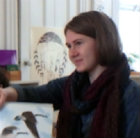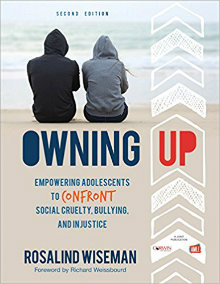Help Students Confront Social Cruelty & Injustice
Owning Up: Empowering Adolescents to Confront Social Cruelty, Bullying, and Injustice, 2nd Ed.
By Rosalind Wiseman
(Corwin, 2017 – Learn more)

Bullying has been a reality for most middle schools forever, and it appears as though it isn’t getting much better in the digital age.
In a world where 70.6% of students say they have witnessed bullying, imagine what would happen if they spoke up or, even better, owned up.

Rosalind Wiseman brings up topics such as gender expectations, the role of gossip, how we create reputations, technology use, race and ethnicity issues, finding support groups, and relationships – and even touches on consent and understanding sexual harassment.
A lot of these topics are very hot and can be difficult to talk about, but Wiseman has a system that is well thought out and sensitive.
Owning Up is a program that takes 17 days, or lessons, to complete. The book provides 17 detailed lessons that include a review of the previous lesson, activities for the current class, and “carry it with you” homework assignments.
Each lesson ranges from 45 minutes to an hour and a half. However, each lesson has a variety of projects and activities so the teacher can pick and choose to make the lesson the length and focus that she or he desires. Although each daily lesson works off the day before, teachers can easily pick out a few lessons that are most relevant to their situation and modify them as needed.
Goals of the Program
What is so great about this program is that Wiseman doesn’t just want students to know that these things exist, but she wants students to notice them in their lives and do their best to make a positive change. In some situations, it might mean the student notices their own negative behaviors and tries to use what they learned in class to break these behaviors and make amends. In other cases, this might mean speaking up to someone who is treating themselves or others poorly.
Methods Used in Lessons
The lessons are primarily discussion-based. For this reason, the teacher must be able to create an environment where students feel safe enough to share their experiences. Wiseman gives several suggestions for how to make discussions anonymous such as writing answers down on paper and then the teacher reading them out loud to the class. However, she offers much more than a discussions approach. The lessons also make use of gallery walks, personal reflections, visualizing projects, videos, and SEAL role plays.
SEAL
SEAL is an acronym that helps people talk to their friends about their negative behaviors. Step number one is to STOP. Stopping means noticing an action that makes you uncomfortable, taking a moment to think through the situation and deciding when is most appropriate to talk to your friend about it.
Once you talk to your friend, you EXPLAIN what you observed and why it makes you uncomfortable. It is also very important to AFFIRM and ACKNOWLEDGE the person you are talking to. This means that you will treat them well with the expectation that they will treat you well in return. Explain your responsibility to speak up and point out any hand you might have played.
By far the most difficult part of seal is LOCK. After the back and forth of the conversation you have three options: to lock into the friendship, take a break from the friendship, or lock out of the friendship. The point of this is to make sure you are surrounding yourself with the best people possible.
Wiseman has had great results using SEAL in her own practice by using role plays. When students do SEAL role plays, they are given a situation where it can be applied. The students are asked to put themselves in that situation and act out how they think this talk would go. It gives the students practice noticing which situations can benefit from SEAL. The practice makes it more likely that the students will use this method in their real lives to confront people who are not being kind to others.
A Powerful Middle School Program
Overall, Owning Up is a powerful program for any middle school. It requires a teacher who is very flexible and comfortable talking about tough topics. The teacher must be open to every idea if he/she is going to get the students to buy into the program.
With successful facilitation and participation, students will come away with a new eye for social justice and will find their voices and speak up for themselves and others. Possibly even more important, students will come away being more conscious of how their actions affect the others around them.
Maeghan Warburton is a teacher certification candidate at College of the Atlantic. She has been working with young children since the age of fourteen and has been taking education classes at COA since sophomore year. She volunteers at local elementary schools during the school year and works at a daycare center during the summer. She has experience working with children as young as five months old through eighth grade.


































